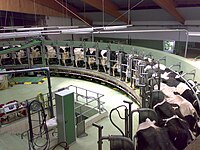
Photo from wikipedia
Thermal treatment is the most popular decontamination technique used in the dairy industry to ensure food protection and prolong shelf life. But it also causes nutrient and aroma degradation, non-enzymatic… Click to show full abstract
Thermal treatment is the most popular decontamination technique used in the dairy industry to ensure food protection and prolong shelf life. But it also causes nutrient and aroma degradation, non-enzymatic browning, and organoleptic changes of dairy products. Non-thermal solutions, on the other hand, have been extensively explored in a response to rising market demand for more sustainable and safe goods. For a long time, the use of ultraviolet (UV) light in the food industry has held great promise. Irradiation with shortwave UV light has excellent germicidal properties, which can destroy a variety of microbial pathogens (for example bacteria, fungi, molds, yeasts, and viruses), at low maintenance and installation costs with minimal use of energy to preserve food without undesirable effects of heat treatment. The purpose of this review is to update the studies made on the possibilities of UV-C radiation while also addressing the essential processing factors involved in the disinfection. It also sheds light on the promise of UV light-emitting diodes (UV-LEDs) as a microbial inactivation alternative to conventional UV lamps.
Journal Title: Applied Sciences
Year Published: 2021
Link to full text (if available)
Share on Social Media: Sign Up to like & get
recommendations!